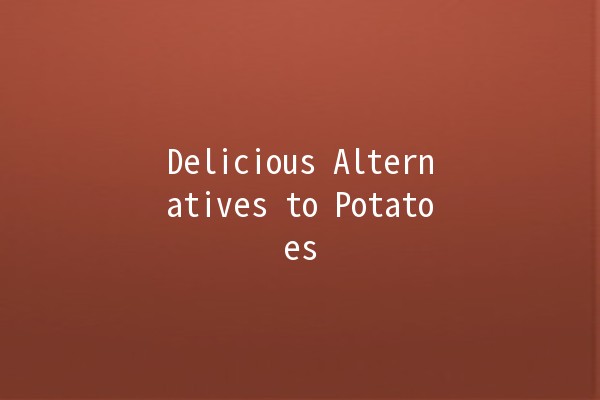When you think of comfort food, potatoes usually come to mind. Whether it’s fluffy mashed potatoes, crispy fries, or baked jackets, potatoes are a staple in many diets around the world. However, if you're looking to mix things up or if you have dietary restrictions, there are plenty of delightful alternatives you can explore. This article will introduce you to various potato substitutes that are not only tasty but also versatile, nutritious, and easy to incorporate into your meals.
What Makes Potatoes So Popular? 🤔
Before we delve into the substitutes, it's essential to understand why potatoes are favored. They are:
Rich in Nutrients: Potatoes provide essential vitamins and minerals, including Vitamin C, B6, and potassium.
Versatile: They can be prepared in myriad ways – boiled, baked, fried, or mashed.
Filling: Potatoes are high in carbohydrates, which means they’re filling and can be satiating.
However, for reasons ranging from dietary needs to culinary curiosity, many are seeking alternative ingredients. Let’s explore some of those.

Why Use Cauliflower?
Cauliflower has gained massive popularity in recent years, especially among those looking to reduce carbohydrate intake. It's an excellent substitute for potatoes due to its texture and mild flavor.
How to Use:
Mashed Cauliflower: Boil cauliflower florets until soft, mash them, and mix with butter and cream for a creamy alternative to mashed potatoes.
Cauliflower Rice: Pulse raw cauliflower in a food processor until it resembles rice. Sauté with your favorite seasonings for a lowcarb side dish.
Fun Tip:
Try roasting cauliflower with spices for a delicious side dish or snack. The edges caramelize beautifully, adding a crunchy texture.
Why Use Sweet Potatoes?
Though still a member of the potato family, sweet potatoes provide a different flavor profile and more nutrients. They’re higher in fiber and vitamins A and C compared to regular potatoes.
How to Use:
Baked Sweet Potatoes: Simply bake until tender, and top with your favorite toppings like Greek yogurt or maple syrup.
Sweet Potato Fries: Cut into wedges, season with olive oil and spices, and roast for a healthier fry alternative.
Fun Tip:
Make a sweet potato mash seasoned with cinnamon and nutmeg for a festive twist on the traditional mashed potatoes!
Why Use Turnips?
Turnips are often overlooked, but they’re low in calories and carbohydrates. They have a slightly peppery flavor which adds uniqueness to your dishes.
How to Use:
Turnip Mash: Similar to mashed potatoes, boil turnips until soft, and mash with butter and spices.
Turnip Fries: Cut turnips into fry shapes and roast; they can become quite crispy and delicious.
Fun Tip:
Combine turnips with carrots and parsnips and roast them together for a colorful and flavorful vegetable medley.
Why Use Quinoa?
Quinoa is a highprotein grain loaded with dietary fiber. It’s glutenfree and has a unique taste that pairs well with many dishes.
How to Use:
Quinoa Salad: Cook quinoa and toss with chopped veggies, nuts, and vinaigrette for a nutritious meal or side.
Quinoa Cakes: Mix cooked quinoa with eggs and seasonings, form patties, and panfry for a delicious alternative to potato cakes.
Fun Tip:
Use quinoa as a base for burrito bowls. Black beans, avocado, and salsa layered over quinoa create a delightful and filling meal.
Why Use Zucchini?
Zucchini is a lowcalorie vegetable that can easily take on the flavors of the dishes it’s cooked with. It’s especially useful for those watching their carbs.
How to Use:
Zucchini Noodles (Zoodles): Spiralize raw zucchini into noodles and toss with marinara or pesto for a light meal.
Zucchini Cakes: Combine grated zucchini with eggs and flour to create savory cakes that can be baked or fried.
Fun Tip:
Stuff hollowed zucchinis with ground meat or beans, season, and bake for a hearty main dish.
Why Use Chickpeas?
Chickpeas are not only high in protein but also provide substantial fiber, making them an excellent potato alternative. Their nutty flavor can add depth to your meals.
How to Use:
Chickpea Mash: Boil chickpeas and mash them with garlic, lemon juice, and tahini for a Mediterraneaninspired dish.
Roasted Chickpeas: Season and roast for a crunchy snack or salad topping.
Fun Tip:
Give chickpeas a try in curries or stews, where they provide both texture and substance.
Why Use Butternut Squash?
Butternut squash is sweet and creamy when cooked, making it a delicious alternative to potatoes. They are rich in vitamins A and C.
How to Use:
Butternut Squash Mash: Boil or steam until soft, then mash with butter for a sweet and creamy side dish.
Roasted Butternut Squash: Cube and roast with olive oil, salt, and pepper for a delightful addition to salads or grain bowls.
Fun Tip:
Use pureed butternut squash in soups or sauces for a naturally sweet flavor boost.
Frequently Asked Questions
Yes! You can use cauliflower in various baked dishes. It works great in casseroles or as a topping for pot pies.
Sweet potatoes can be boiled or baked and served alongside eggs or turned into pancakes by mashing, adding eggs, and cooking like a pancake.
Turnips have a peppery flavor, while sweet potatoes are sweeter. However, both offer unique taste profiles worth trying.
Yes! Quinoa can replace rice in most dishes. Its nutty flavor enhances salads and bowls, and it's excellent in stirfries.
To reduce moisture, salt sliced zucchini for about 20 minutes, then pat dry before cooking. This will concentrate the flavors.
Chickpeas can be integrated into salads, soups, or blended into hummus. Try roasted chickpeas as a healthy snack or a salad topper.
🌈
Exploring alternatives to potatoes opens a world of new flavors and textures in your meals. Whether you're looking to reduce carbohydrates or simply trying something new, these substitutes can delight your palate. With a little creativity, you can enjoy nutritious and satisfying dishes that keep your diet exciting and healthy.
Take these suggestions as a starting point; the possibilities are endless, and your taste buds will thank you!